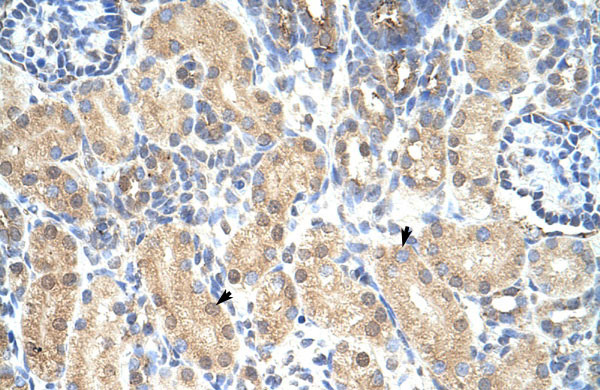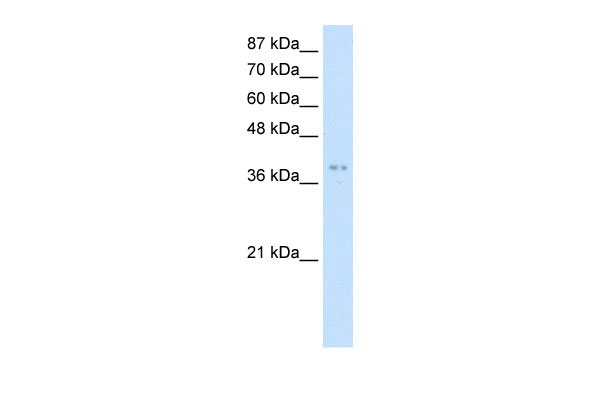PRMT1 antibody - middle region
Rabbit Polyclonal Antibody
- 产品详情
- 实验流程
Application
| WB, IHC |
|---|---|
| Primary Accession | Q99873 |
| Other Accession | NM_001536, NP_001527 |
| Reactivity | Human, Mouse, Rat, Rabbit, Zebrafish, Pig, Dog, Horse, Bovine |
| Predicted | Human, Mouse, Rabbit, Zebrafish, Pig, Bovine |
| Host | Rabbit |
| Clonality | Polyclonal |
| Calculated MW | 42462 Da |
| Gene ID | 3276 |
|---|---|
| Alias Symbol | ANM1, HCP1, IR1B4, HRMT1L2 |
| Other Names | Protein arginine N-methyltransferase 1, 2.1.1.-, Histone-arginine N-methyltransferase PRMT1, 2.1.1.125, Interferon receptor 1-bound protein 4, PRMT1, HMT2, HRMT1L2, IR1B4 |
| Format | Liquid. Purified antibody supplied in 1x PBS buffer with 0.09% (w/v) sodium azide and 2% sucrose. |
| Reconstitution & Storage | Add 100 ul of distilled water. Final anti-PRMT1 antibody concentration is 1 mg/ml in PBS buffer with 2% sucrose. For longer periods of storage, store at 20°C. Avoid repeat freeze-thaw cycles. |
| Precautions | PRMT1 antibody - middle region is for research use only and not for use in diagnostic or therapeutic procedures. |
| Name | PRMT1 (HGNC:5187) |
|---|---|
| Function | Arginine methyltransferase that methylates (mono and asymmetric dimethylation) the guanidino nitrogens of arginyl residues present in proteins such as ESR1, histone H2, H3 and H4, FMR1, ILF3, HNRNPA1, HNRNPD, NFATC2IP, SUPT5H, TAF15, EWS, HABP4, SERBP1, RBM15, FOXO1, CHTOP, MAP3K5/ASK1, MICU1 and NPRL2 (PubMed:10749851, PubMed:15741314, PubMed:16879614, PubMed:18951090, PubMed:22095282, PubMed:25284789, PubMed:26575292, PubMed:26876602, PubMed:27642082, PubMed:30765518, PubMed:31257072, PubMed:38006878). Constitutes the main enzyme that mediates monomethylation and asymmetric dimethylation of histone H4 'Arg-3' (H4R3me1 and H4R3me2a, respectively), a specific tag for epigenetic transcriptional activation. May be involved in the regulation of TAF15 transcriptional activity, act as an activator of estrogen receptor (ER)-mediated transactivation, play a key role in neurite outgrowth and act as a negative regulator of megakaryocytic differentiation, by modulating p38 MAPK pathway. Methylates RBM15, promoting ubiquitination and degradation of RBM15 (PubMed:26575292). Methylates MRE11 and TP53BP1, promoting the DNA damage response (PubMed:15741314, PubMed:16294045, PubMed:29651020). Methylates FOXO1 and retains it in the nucleus increasing its transcriptional activity (PubMed:18951090). Methylates CHTOP and this methylation is critical for its 5-hydroxymethylcytosine (5hmC)-binding activity (PubMed:25284789). Methylates MAP3K5/ASK1 at 'Arg-78' and 'Arg-80' which promotes association of MAP3K5 with thioredoxin and negatively regulates MAP3K5 association with TRAF2, inhibiting MAP3K5 stimulation and MAP3K5-induced activation of JNK (PubMed:22095282). Methylates H4R3 in genes involved in glioblastomagenesis in a CHTOP- and/or TET1- dependent manner (PubMed:25284789). Plays a role in regulating alternative splicing in the heart (By similarity). Methylates NPRL2 at 'Arg-78' leading to inhibition of its GTPase activator activity and then the GATOR1 complex and consequently inducing timely mTORC1 activation under methionine-sufficient conditions (PubMed:38006878). |
| Cellular Location | Nucleus. Nucleus, nucleoplasm {ECO:0000250|UniProtKB:Q9JIF0}. Cytoplasm. Cytoplasm, cytosol {ECO:0000250|UniProtKB:Q9JIF0}. Lysosome membrane. Note=Mostly found in the cytoplasm Colocalizes with CHTOP within the nucleus. Low levels detected also in the chromatin fraction (By similarity). Upon methionine stimulation, localizes to the lysosome membrane in an NPRL2-dependent manner (PubMed:38006878). {ECO:0000250|UniProtKB:Q9JIF0, ECO:0000269|PubMed:38006878} |
| Tissue Location | Widely expressed (PubMed:11097842). Expressed strongly in colorectal cancer cells (at protein level) (PubMed:28040436). Expressed strongly in colorectal cancer tissues compared to wild-type colon samples (at protein level) (PubMed:28040436). Expressed strongly in colorectal cancer tissues compared to wild-type colon samples (PubMed:28040436) |
Research Areas
For Research Use Only. Not For Use In Diagnostic Procedures.
Application Protocols
Provided below are standard protocols that you may find useful for product applications.
REFERENCES
Adams,M.M., (2005) Cell Cycle 4 (12), 1854-1861Reconstitution and Storage:For short term use, store at 2-8C up to 1 week. For long term storage, store at -20C in small aliquots to prevent freeze-thaw cycles.
终于等到您。ABCEPTA(百远生物)抗体产品。
点击下方“我要评价 ”按钮提交您的反馈信息,您的反馈和评价是我们最宝贵的财富之一,
我们将在1-3个工作日内处理您的反馈信息。
如有疑问,联系:0512-88856768 tech-china@abcepta.com.























 癌症的基本特征包括细胞增殖、血管生成、迁移、凋亡逃避机制和细胞永生等。找到癌症发生过程中这些通路的关键标记物和对应的抗体用于检测至关重要。
癌症的基本特征包括细胞增殖、血管生成、迁移、凋亡逃避机制和细胞永生等。找到癌症发生过程中这些通路的关键标记物和对应的抗体用于检测至关重要。 为您推荐一个泛素化位点预测神器——泛素化分析工具,可以为您的蛋白的泛素化位点作出预测和评分。
为您推荐一个泛素化位点预测神器——泛素化分析工具,可以为您的蛋白的泛素化位点作出预测和评分。 细胞自噬受体图形绘图工具为你的蛋白的细胞受体结合位点作出预测和评分,识别结合到自噬通路中的蛋白是非常重要的,便于让我们理解自噬在正常生理、病理过程中的作用,如发育、细胞分化、神经退化性疾病、压力条件下、感染和癌症。
细胞自噬受体图形绘图工具为你的蛋白的细胞受体结合位点作出预测和评分,识别结合到自噬通路中的蛋白是非常重要的,便于让我们理解自噬在正常生理、病理过程中的作用,如发育、细胞分化、神经退化性疾病、压力条件下、感染和癌症。







